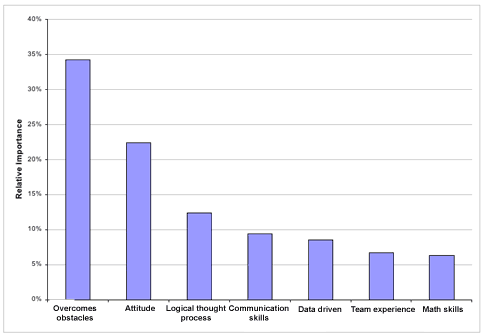Reviewing Success Factors of a Six Sigma Black Belt
How to determine the "can-do" from the "can't-do" attitude.
Today I received a sales call from a person interested in becoming a certified Six Sigma Black Belt. He had what I call a "can't do" personality. This is the diametric opposite of the "can do" person. This type of individual looks for reasons why a particular thing can't be done. How about a project in the sales department? No way, sales people won't go for it, sales isn't a process anyway, management won't let us touch the sales area, and so on.
Successful change agents are invariably can-do people. To be sure they spend a lot of time planning to avoid obstacles, but when they encounter the inevitable obstacle, they don't shrink from the challenge. They find ways over, under, around, or through the obstacle. They won't be stopped. They are relentless pursuers of change.
I once had the opportunity to work with a major aerospace client to study the success factors for their Six Sigma Black Belts. We reviewed the histories of a number of Black Belts who had success levels that varied from poor to excellent.
After coming up with a list of the factors that seemed to have an effect on success, we went through an exercise to determine the importance weights. Using the Analytic Hierarchical Process (AHP) the Six Sigma Champion, Master Black Belts, and I came up with the weights shown in figure 1.

Figure 1-Black Belt Success Factor Weights
The weights are, of course, subjective and only approximate. Feel free to modify them if you feel strongly that they're incorrect. Better yet, you may want to identify your own set of criteria and weights. The important thing is to determine the criteria and then develop a method of evaluating candidates on each criterion. The sum of the candidate's criterion score times the criterion weight will give you an overall numerical assessment that can be useful in sorting out those candidates with high potential from those less likely to succeed as Black Belts. Of course, the numerical assessment is not the only input into the selection decision, but it is a very useful one.
You may be surprised to see the low weight given to math skills. The rationale is that Black Belts will receive 200 hours of training, much of it focused on the practical application of statistical techniques using computer software and requiring very little actual mathematics. Software automates the analysis, making math skills less necessary.
The mathematical theory underlying a technique is not discussed beyond the level necessary to help the Black Belt properly apply the tool. Black Belts who need help with a particular tool have access to Master Black Belts, other Black Belts, consultants, professors, and a wealth of other resources. Most statistical techniques used in Six Sigma are relatively straightforward and often graphical; spotting obvious errors is usually not too difficult for trained Black Belts. Projects seldom fail due to a lack of mathematical expertise.
In contrast, the Black Belt will often have to rely on his or her own abilities to deal with the obstacles to change they will inevitably encounter. Failure to overcome the obstacle will often spell failure of the entire project.

Comentarios